
Ashley Graves
Dose Dependent Electrophysiological Responses to Yeast-Derived Volatiles in Drosophila
Ashley Graves, Nicole Scheidler, and Zain Syed

Ashley Graves
The invasive, pestiferous fruit fly, Drosophila suzukii, is unique among the fruit fly complex (represented by ~ 3000 species) in its ability to oviposit in and feed on fresh fruit. In recent years, the fresh fruit trade has sustained substantial damage in parts of the United States due to the presence of D. suzukii. All pest control practices rely on reliable monitoring of pest populations in the field that is often accomplished by field traps that are often baited with a lure, either based on sex pheromones and/or host-derived odors. As common to other fruit flies, D. suzukii lacks strong sex pheromone based communication. In light of that, attempts have been made to formulate a bait based on food-substrates. However, efforts have been ineffective, capturing many non-suzukii arthropod species, in addition to other fruit flies. Studies at the Syed laboratory have earlier identified a range of yeast based volatiles that generated differential electrophysiological responses from D. suzukii as compared to D. melanogaster (common vinegar/fruit fly). The main objective of this study was to determine the sensory threshold of these compounds in order to formulate a bait that can preferentially attract D. suzukii in the field. Preliminary data comparing olfactory responses from two fly species revealed differences between sex, species, and concentrations.
ARF6-mediated regulation of tumor microvesicle formation
Emma McGrath and Crislyn D’Souza-Schorey
The ability of cancer cells to invade through local basement membrane and extracellular matrix and penetrate into surrounding tissues is an important step in the metastatic process. Altered regulation of signalling pathways that control cell motility often contribute to the invasive phenotype, thus directly influencing cancer initiation and progression. Two discrete invasive structures, microvesicles and invadopodia, are often observed in certain tumor cell lines. Previous work in our lab has identified the small GTPase ARF6, which functions as a regulator of endocytic trafficking and cytoskeletal remodelling, as a common critical determinant in activating these differential signalling pathways. Microvesicles bud by means of outward fission from the plasma membrane via an actomyosin contraction mechanism, which is controlled by regulatory phosphorylation sites on the myosin light chain (MLC) subunit. ARF6GTP-mediated activation of myosin light chain kinase (MLCK) phosphorylates residues that increase Mg2+-ATPase activity of the myosin head domains, whereas ARF6GDP stimulates Protein Kinase C-mediated phosphorylation of MLC inhibitory sites, attenuating contractile force by rendering the protein a poorer substrate for MLCK. Using site directed mutagenesis and immunofluorescent imaging, we are examining the effect of these characterised phosphorylation sites on microvesicle shedding from the cell surface, as well as determining whether PKC signaling also modulates invadopodia formation.
Developing an effective immunotoxin that targets cells overexpressing ErbB2
Luqun Shen, Kelsey Weigel, Clayton Thomas, Lauren Drapalik, Shaun Lee and Zachary Schafer
Approximately 30% of all breast cancers involve the overexpression of ErbB2, which can promote cell proliferation and oppose apoptosis. Currently, the best treatment option for ErbB2 positive breast cancers is the drug Herceptin. But while Herceptin has shown promise, patients are known to eventually develop resistance to the drug, leading to the need to implement alternative methods of treatment. One example of alternative treatments that are being investigated to overcome these shortcomings are immunotoxins. Immunotoxins are composed of a targeting ligand and a toxin, allowing for the selective destruction of cancer cells. Here we attempt to develop an immunotoxin that will specifically target cells overexpressing ErbB2 while also being less prone to cells becoming resistant to it. First, cells overexpressing ErbB2 were treated with a variety of peptides that included only the toxic amino acid sequence of the toxin and, utilizing an ethidium homodimer assay, cell death was assessed. We determined that the peptide NL11-PSA showed the strongest toxicity and specificity of all the peptides tested. In addition to screening these peptides, we have attempted to produce an immunotoxin composed of a targeting ligand and the toxin recombinantly. In tandem, these approaches represent a multi-faceted approach to target ErbB2 and our data suggests that NL11-PSA could be used as an effective therapeutic to eliminate ErbB2 positive breast cancer cells.
Characterization of transgenic tumor models using 3D organoid culture techniques
Hannah Garcia (1,2), Christopher Suarez (1,2), Chen Dai (1,2), Emilia Hartland (1,2) and Laurie Littlepage (1,2)
1: Harper Cancer Research Institute; 2: Department of Chemistry and Biochemistry,
University of Notre Dame
Breast cancer is second only to lung cancer as the leading cause of cancer related death for women. Many labs use transgenic mouse tumor models and a variety of cell culture techniques to study different aspects of breast cancer. While both methods and combinations of these methods have been useful, they have drawbacks. Cell culture is two dimensional and lacks the ability to study cancer cells as they would behave in a three dimensional tumor environment. In contrast, transgenic mouse models allow us to study tumors in three dimensions, but we cannot study the molecular processes and development associated with cancer progression. However, by using organoid technique we can bridge this gap. In this technique, tumors are digested into small functional tissue clusters, organoids, and plated in a 3D matrix for a time lapse imaging study. In this study, tumors were extracted for organoid preparation from two different mice whose tumors are driven by different oncogenes, PyMT and Wnt1. Control organoids were prepared from normal mammary glands from wild type mice. Comparative analysis was conducted systematically scoring organoids across different transgenic mouse tumor models. Categories scored include: protrusive/invasive buds, rounded buds, and total disseminated cells for each scene of organoids. In future work, the scoring system will be used to characterize patient derived tumor xenografts, to better understand human tumor behavior. Applications of this technique and scoring system will allow future researchers to design organoid based experiments to explore molecular processes concerning tumor development, cancer progression, metastasis, and tumor environment interaction with controlled conditions.
Macaca fascicularis population structuring dictates distribution of genetic variation in Blastocystis across two islands in Southeast Asia.
Raquel Montañez, Hope Hollocher and Justin Wilcox
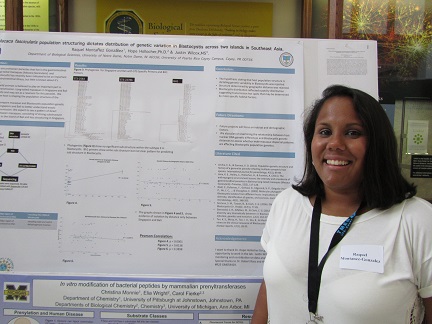
Raquel Montañez
Blastocystis are protozoan parasites that live in the gastrointestinal tracts of long-tailed macaques (Macaca fascicularis) and humans, among other species. Blastocystis transmission routes remain largely unknown and unstudied. Blastocystis infection in humans is known to cause severe diarrhea and gastrointestinal tract infections. Long-tailed macaques in Singapore and Bali, Indonesia, have constant contact with humans and are know to harbor Blastocystis. Our hypothesis is that the host is shaping the population structure of the parasite. By looking at the population structuring of the parasite we expect to get a better idea of the transmission route. If the parasite population structuring matches that of the host, then a fecal-oral transmission route is implicated. If these patterns do not match, then other factors must be involved. To address this question, DNA was extracted from stool samples of long-tailed macaques. DNA was amplified with subtype 3 specific primers and sequenced at 1 and 4 loci to detect variation within the subtype. Preliminary results show some sub structuring in nuclear DNA and no significant sub structuring in mitochondrial like organelle DNA. Suggesting that the population structuring of the long-tailed macaques is not directly responsible for the Blastocystis population structuring.
Discovery and validation of a Y-locus in Aedes aegypti and determination of polyandry
Alejandra Ortiz, Diane Lovin and David Severson
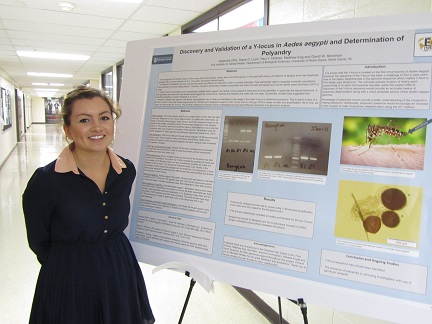
Alejandra (Lexi) Ortiz
Aedes aegypti is the primary vector of the viruses that cause dengue, yellow fever and Chikungunya. In the past half century, prevalence of dengue fever has drastically emerged with a current estimate of 50 to 100 million individuals infected yearly. The absence of available vaccines requires that vector populations be reduced in order to combat outbreaks. Past techniques used to suppress mosquito populations have generally not shown lasting effects. Therefore, interest in genetically modified mosquitoes has arisen through techniques such as the sterile insect technique (SIT) in males. However, in order to have a successful cycle of genetically modified Aedes aegypti, the details of the mosquito’s behaviors must be identified, in particular the sexual behaviors. It has generally been assumed that female Aedes aegypti are monandrous, meaning that females only mate with one male. Conversely, studies have suggested that possible polyandry is present (Helinski et al. 2012). However, multiple male sperm in the female spermathecae has not been yet identified by the usage of the male Y-locus to determine polyandry. This is due to a lack of a known Y-locus in the male Aedes aegypti genome. Primers were designed in search of the Y-locus and run through PCR in search of male only amplification. As of now, we have not discovered the Y-locus. The possible presence of polyandry was subsequently investigated through spermathecae dissection and genotypic analysis.
Effect of substrate on transport of corn pollen in streams at LEEF
Caleb M. Bomske, Arial J. Shogren, Jennifer L. Tank and Sheila F. Christopher
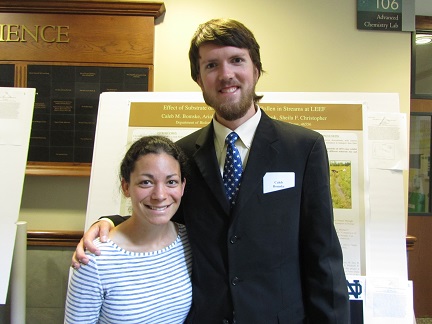
Ariel Shogren and Caleb Bomske
Substrate affects the concentration and transport rate of environmental DNA in streams. The ability of a stream to retain environmental DNA (eDNA) is largely dependent on the composition of the substrate. We conducted our experiment at the University of Notre Dame’s innovative Linked Experimental Ecosystem Facility (LEEF) at St. Patrick’s County Park, and used corn pollen as an FPOM substitute to mimic the movement of eDNA in a stream. At LEEF, semi-natural streams mimic the movement and flow of natural streams. We used four types of substrate for comparison in each of the four streams including pea gravel, cobblestone, a 50/50 mixture of pea gravel and cobblestone, and an alternating pattern of two meters of pea gravel to two meters of cobblestone. The corn pollen was pulse-released in each of the four streams. We monitored concentration fluctuations of the corn pollen at four sites along the 50-meter reach of the stream, ten meters apart to capture the pulse of corn pollen as it dispersed downstream. Results suggest that pea gravel has a higher retention of corn pollen than cobble, with the mixed and alternating substrate intermediate between the two. Therefore, finer substrates retain more corn pollen than course ones. The relationships demonstrated by this experiment are vital to a comprehensive understanding of eDNA source location in streams.
A new intervention for malaria control in the Solomon Islands: Insecticide-impregnated barriers
Nicholas Deason and Neil Lobo
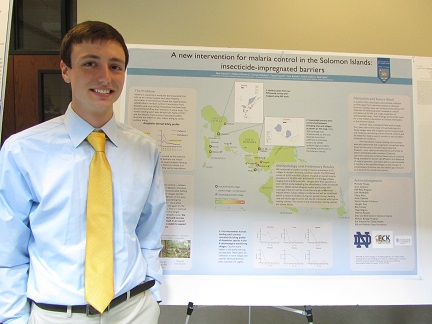
Nicholas Deason
Malaria is a mosquito-borne disease that affects millions of people each year, with over 600,000 deaths globally in 2012. Recently, Solomon Islands set a goal of nationwide malaria elimination. Decades of long-lasting insecticidal nets (LLIN) and indoor residual spraying (IRS) interventions have greatly reduced, but not eliminated malaria in Solomon Islands. Instead, the primary malaria vector, Anopheles farauti, has undergone a shift from late-night endophagic bloodfeeding to early-evening exophagic bloodfeeding. Presumably, these behaviors are selected for by LLINs and IRS, which may have reached the limit of their effectiveness. Thus, behavioral resistance could be a contributing factor to the persistence of malaria transmission. Our project will test the effectiveness of a novel outdoor intervention, insecticide-impregnated barriers (IIBs), at reducing malaria transmission over a period of 2 years. We conducted a baseline survey of malaria prevalence using 3,837 volunteer individuals in 19 villages across 5 islands in Western Province, Solomon Islands. The PCR-based survey revealed an overall malaria prevalence of 16.59%, with Plasmodium vivax accounting for the majority of infections. We also report here the first known occurrence of P. ovale in the Solomon Islands. This summer, we mapped study villages using geographic information system (GIS) devices, constructed IIBs in intervention villages, and distributed radical cure treatment to members of our incidence-monitoring cohort. The incidence of malaria infection in the cohorts will now be monitored over the next 2 years and compared between IIB villages and control villages with no intervention. Mosquitoes will also be collected in human landing catches to determine infection rates and changes in age structure over the ensuing study period. We hypothesize that the IIBs will reduce malaria transmission to almost zero over the study period as a result of the strategic placement of the interventions. We also hypothesize that the IIBs will target older mosquitoes, and expect to see a shift to a younger age structure in the vector population.
Characterization of genes that govern retinal patterning in Aedes aegypti
Hannah Birky

Hannah Birky
Studying the visual system of the Aedes aegypti mosquito could provide novel avenues for vector control and disease transmission intervention, including the creation of visual mutants and improved mosquito traps involving visual cues. The Aedes aegypti retina is composed of four distinct regions—the dorsal, central, ventral stripe, and ventral regions—distinguished by the rhodopsins expressed in the R7 photoreceptor cells. This study examines the expression of transcription factors governing this retinal patterning. Five transcription factors, homothorax (Hth), Iroquois complex (IRO-C), wingless (wg), orthodenticle (otd), and spineless (ss), were chosen to study because they are known to determine cell fate in Drosophila by specifying which rhodopsin is expressed in each photoreceptor cell. The current study examines these transcription factors in adult Aedes aegypti using in situ hybridization, modeled from the protocol for zebra fish embryos. A 200-400 base pair region of each gene was PCR amplified and cloned into the TOPO2.1 vector. An EcoR1 cut was used to check for the presence of the insert in the plasmid vector. After a series of minipreps and midipreps, the plasmid was linearized with a BamH1 cut. The linearized DNA was then purified and used to make digoxigenin (DIG)-labeled RNA probes. Heads from white-eyed Aedes aegypti one to four days post-eclosion were fixed, and then whole mount retinas were dissected before being treated with the DIG RNA probes. The probes were detected in the retinas with an anti-DIG antibody conjugated to alkaline phosphatase and colorimetric (NBT and BCIP) substrates. When a stain appeared on the retinas, they were then mounted and imaged with a light microscope. This study will shed light on the genetic basis for retinal patterning in Aedes aegypti and open doors to create and study visual mutants, ultimately for the purpose of contributing to vector control efforts.
Characterization of rod precursor proliferation and differentiation in the adult zebrafish retina
Samantha Piekos, Manuela Lahne and David Hyde
Two hundred eighty-five million people worldwide are visually impaired, and many exhibit a progressive and irreversible vision loss. If it were possible to regenerate the damaged/lost retinal neurons, their vision could be restored. In contrast, zebrafish can regenerate all their retinal cell types, making it an ideal organism to study neuronal regeneration and elucidate the mechanisms that could restore sight to the visually impaired. Zebrafish rod precursor cells, which arise from proliferating Müller glia, are required for the persistent production of rod photoreceptors throughout the life of the fish. It was previously described that rod precursor cells increase their rate of proliferation in response to light-induced rod photoreceptor death. We examined rod precursor cell proliferation and demonstrate that there is no significant difference in the number of proliferating rod precursor cells in both undamaged and light-damaged retinas that were dark-adapted. However, undamaged dark-adapted fish possess significantly greater numbers of proliferating rod precursor cells relative to fish that are maintained in standard light conditions. These data suggest that prolonged dark adaptation induces rod precursor proliferation rather than light-induced rod photoreceptor cell death. To determine the onset and contribution of Müller glia proliferation to the increased dark-adapted rod precursor proliferation response, we are carrying out a detailed timecourse analysis (0, 2, 5, 8, 11, and 14 days) using Tg[gfap:EGFP] zebrafish, which express EGFP specifically in Müller glia. In addition, we are testing the possibility that increased cell death causes elevated rod precursor cell proliferation during dark adaption using the TUNEL assay.
Effects of glucose and phosphorous limitation on growth and uptake kinetics of freshwater bacteria
Ana Illera, Hildamarie Caceres-Velazquez and Stuart Jones
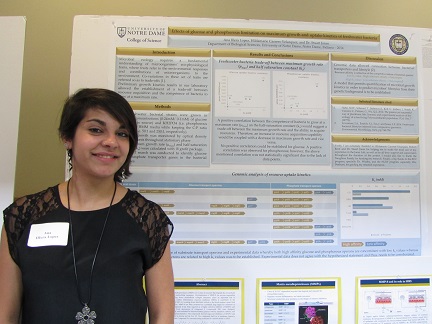
Ana Illera
Microbial ecology requires a fundamental understanding of microorganisms’ eco-physiological traits, where traits refer to the environmental responses and contributions of microorganisms to the environment. Co-variations in these set of traits are referred so as to trade-offs. Preliminary growth kinetics results in our laboratory allowed the establishment of a trade-off between resource acquisition and the competence of bacteria to grow at a maximum rate. Bacterial cell growth is controlled by the rate of active transport of a limiting substrate, and thus, association between cell growth and specific substrate transporters is established. A connection among bacterial growth kinetics, defined in terms of µmax and Ks, and cell growth is then to be determined. Subsequent relationship between bacterial kinetic capabilities and genetic information based on substrate transporters is fundamental to further understand bacterial lifestyles. To generate traits-level understanding of bacterial ecology, a combination of classical microbiology methods, whereby bacterial specific growth rate was monitored over time by measuring the optical density of the cultures at different substrate concentration to obtain kinetic data (i.e. µmax and Ks, based on Monod’s model), data analysis and comparative genomics was exploited. This study verified the trade-off between the ability to acquire glucose and phosphorous and the competence to grow at a maximum growth rate for six freshwater bacterial strains. A connection between freshwater bacterial transporters and lifestyle to establish a model that allows quantification of microbial growth kinetics in order to predict microbes’ lifestyles from their genetic background was consequently ascertained.
Identification of novel insecticide targets in Anopheles gambiae G-protein coupled receptors
Tyler Gibson
Mosquito-borne diseases represent an immense global health burden, afflicting hundreds of millions of people worldwide. Insecticides have always been one of the most effective forms of combatting the transmission of these diseases. However, widespread insecticide resistance poses a major challenge to vector control initiatives, necessitating the development of novel insecticides. The membrane bound signaling molecules, G protein-coupled receptors (GPCRs) are promising candidates for insecticide development. These receptors are involved in many indispensable physiological processes in insects, and appear to act as neuromodulators of olfaction, locomotion, and development. This study focuses on the tachykinin receptor of Anopheles gambiae. Using real time PCR, the expression of the receptor was quantified in all life stages of the mosquito. Using, molecular cloning, the tachykinin receptor was cloned into a luciferase reporter construct and transfected into HEK-293 cells. Furthermore, the ligands for the receptor were predicted using comparative genomics. The establishment of a stable cell line and the prediction of the receptor ligands will allow future research to test potentially insecticidal compounds against the tachykinin receptor.
AS-PCR as a diagnostic for differentiating between Anopheles funestus chromosomal forms:
Folonzo and Kiribina
A. Hendershot (1), C. Witzig (1), M. Fontaine (1), H.A. Smith (1), A. Steele (2), S. Emrich (2), M. Guelbeogo (3), N’.F. Sagnon (3) and N. Besansky (1)
1: Eck Institute for Global Health, University of Notre Dame; 2: Department of Computer Sciences and Engineering, University of Notre Dame; 3: Centre National de Recherche et Formation sur le Paludisme, Ouagadougou, Burkina Faso
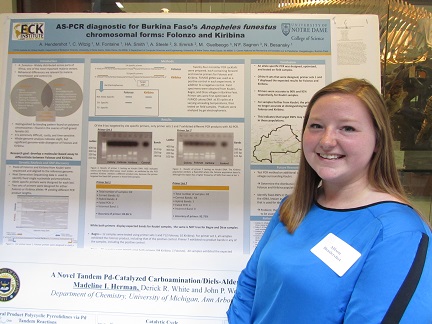
Allison Hendershot
Anopheles funestus is regarded as one of the most important African vectors of malaria. In Burkina Faso, researchers have identified two different chromosomal forms of this species—Folonzo and Kiribina, that inhabit the same geographic area. Despite their closeness, they do not seem to interbreed, as indicated by the lack of heterokaryotypes. These forms exhibit a difference in behavioral patterns that can affect the control and prevention of malaria transmission. Because current methods of distinguishing between these forms are difficult and costly, this study looks to investigate Allele Specific-PCR as a method for differentiation between Folonzo and Kiribina. Next generation sequencing of DNA samples from Kuiti was used to identify fixed single nucleotide polymorphisms (SNPs) between the two forms —which served as the targets for the design of nine site-specific primer cocktails. Each cocktail, containing forward and reverse primers for Folonzo and Kiribina, was tested on remaining Kuiti DNA. Of the nine cocktails, two were successful in accurately differentiating between the two chromosomal forms with 90% accuracy or better—including failed, abnormal, and incorrect results. When successful primers were tested on karyotyped specimens from neighboring villages, Bagre and Dirze, PCR products did not exhibit the expected banding patterns. These results indicate the presence of a fixed SNP in the Kuiti population that may not be present in the Bagre and Dirze populations, possibly due to geographical distance. Future research includes testing of additional samples from villages surrounding Kuiti, to assess the distribution of the targeted SNP and identifying other areas for fixed SNPs that might be distributed among all Folonzo and Kiribina populations.